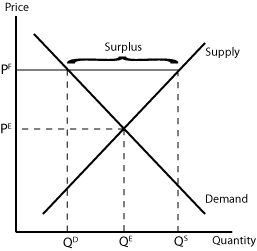Equilibrium
Equilibrium: The point in which the supply curve intersects with the demand curve.
Excess Demand: Occurs when quantity demanded is greater than quantity supplied. This will result in a shortage.
- Shortage: Consumers cannot get the quantities of the items they need
- Created by Price Ceiling
- Price Ceiling: When the Government puts a legal limit on how high the price of a product can be
- *Example: Rent Control
Excess Supply: Occurs when quantity supplied is greater than quantity demanded. This will result in a surplus.
- Surplus: Producers have inventories that they cannot get rid of
- Created by Price Floor
- Price Floor: The lowest legal price a commodity can be sold at.
- Government uses this to prevent prices from becoming to low
- *Example: Minimum Wage







